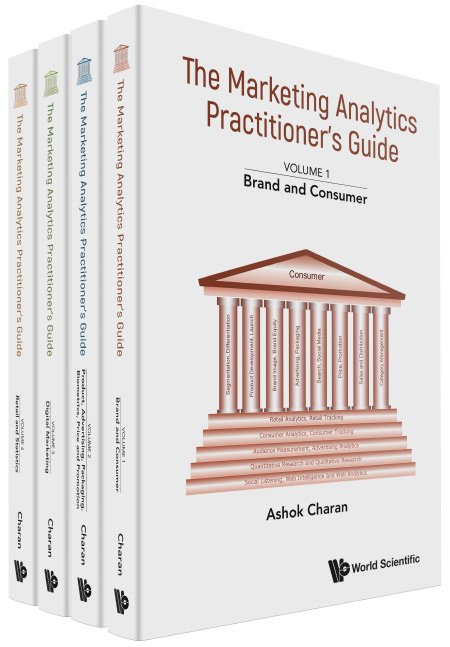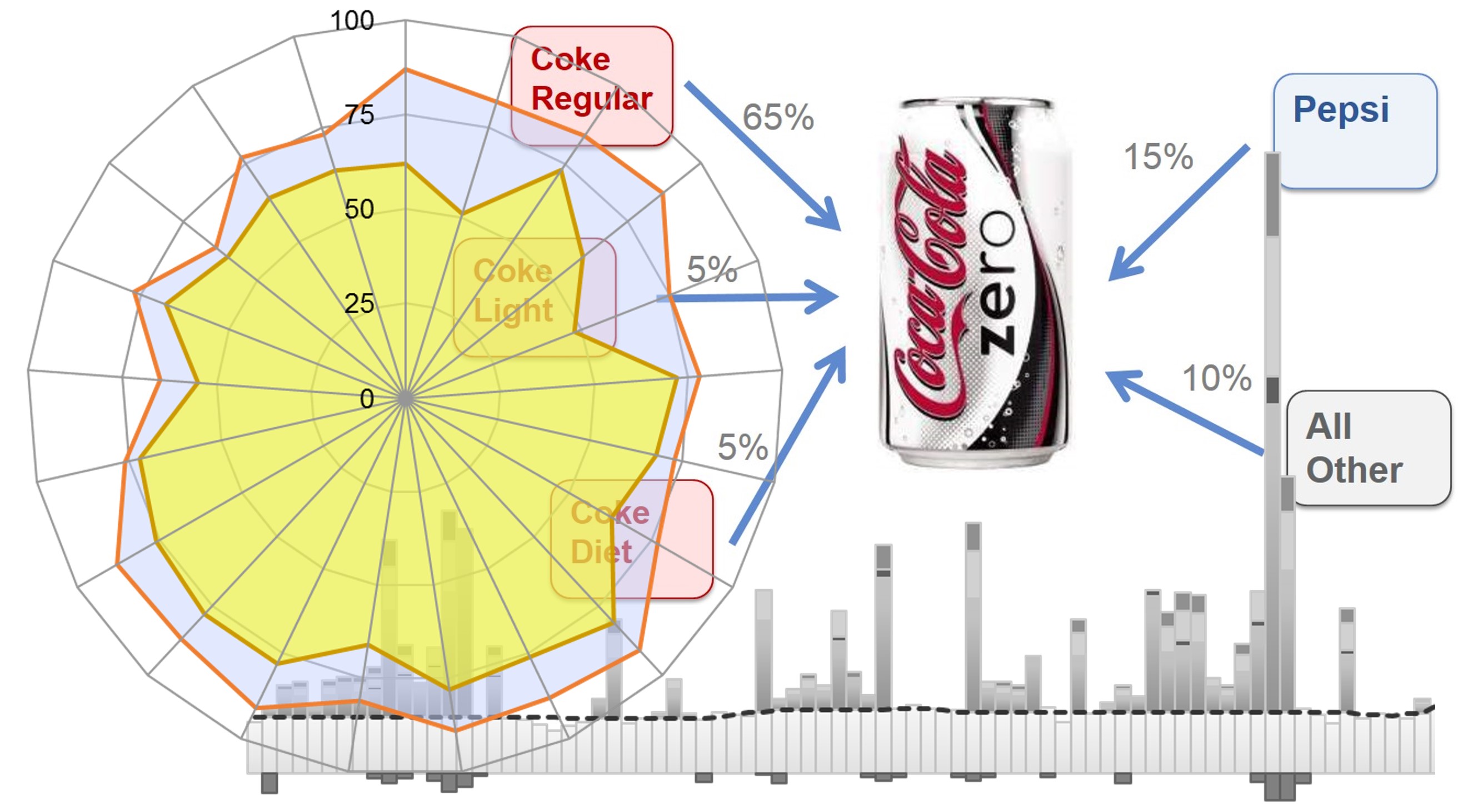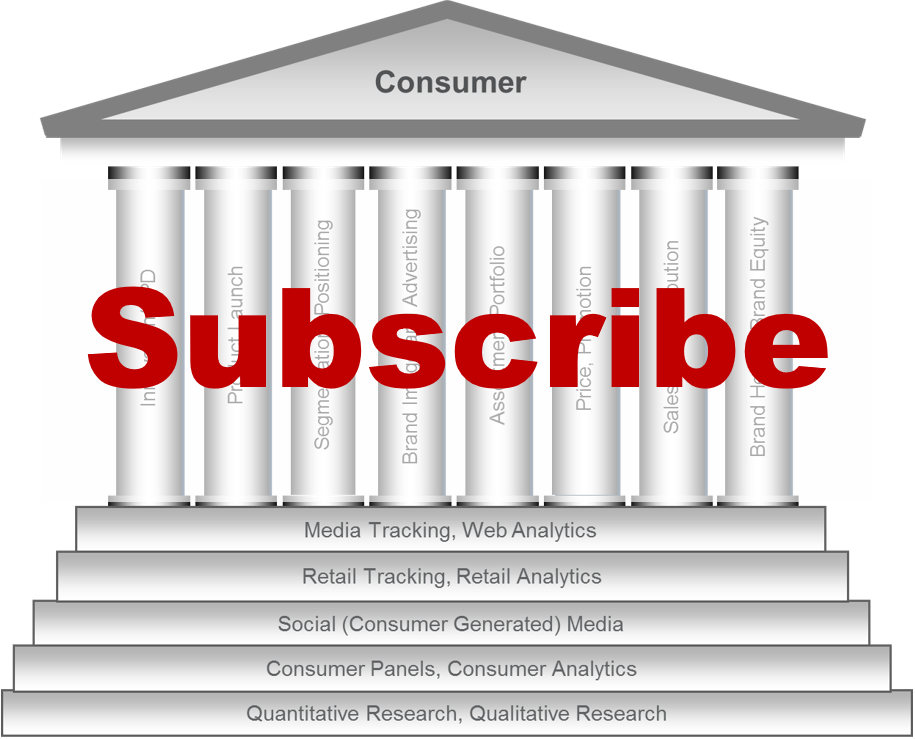The Marketing Analytics Practitioner’s Guide
-
Chapters
Marketing Analytics
- CONTENTS
BRAND
Brand Sensing
Brand Equity
CONSUMER
Segmentation
Qualitative Research
Quantitative Research
Customer Satisfaction and Customer Value
Consumer Analytics and Consumer Panels
Consumer Analytics and Big Data
PRODUCT
New Product Development
Product Design
Product Validation
ADVERTISING, PACKAGING AND BIOMETRICS
How Advertising Works
Advertising Analytics
Packaging
Biometrics
PRICE AND PROMOTION
Price
Promotion
DIGITAL
New Media
Digital Marketing
Facebook
Twitter
Instagram
YouTube
LinkedIn
SEO
Search Advertising
Web Analytics
Digital — Execution
RETAIL
Retail Tracking
Sales and Distribution
Retail Analytics
Category Management
- STATISTICS
Basic Statistics
Sampling
Market Mix Modelling
- REFERENCES
Marketing Analytics
- CONTENTS
BRAND
Brand Sensing
Brand Equity
CONSUMER
Segmentation
Qualitative Research
Quantitative Research
Customer Satisfaction and Customer Value
Consumer Analytics and Consumer Panels
Consumer Analytics and Big Data
PRODUCT
New Product Development
Product Design
Product Validation
ADVERTISING, PACKAGING AND BIOMETRICS
How Advertising Works
Advertising Analytics
Packaging
Biometrics
PRICE AND PROMOTION
Price
Promotion
DIGITAL
New Media
Digital Marketing
Facebook
Twitter
Instagram
YouTube
LinkedIn
SEO
Search Advertising
Web Analytics
Digital — Execution
RETAIL
Retail Tracking
Sales and Distribution
Retail Analytics
Category Management
- STATISTICS
Basic Statistics
Sampling
Market Mix Modelling
- REFERENCES


The Marketing Analytics Practitioner’s Guide
As the use of analytics becomes increasingly important in today’s business
landscape, The Marketing Analytics Practitioner’s Guide (MAPG) provides a thorough understanding
of marketing management concepts and their practical applications, making it a valuable resource
for professionals and students alike.
The four-volume compendium of MAPG provides an in-depth look at marketing management concepts and their practical applications, equipping readers with the knowledge and skills needed to effectively inform daily marketing decisions and strategy development and implementation. It seamlessly blends the art and science of marketing, reflecting the discipline’s evolution in the era of data analytics. Whether you are a seasoned marketer or new to the field, the MAPG is an essential guide for mastering the use of analytics in modern marketing practices.
Testimonials
“I have been working for a global FMCG company as a design manager for the past 10 years. In my mind, I always had an unclear picture—why am I doing this, and what is it all for? After a 12-week journey with Professor Ashok Charan, I am now able to see that picture much more clearly. It helps me understand the purpose of my work and also find a better way of working with my colleagues in different departments.”
Senior Design Manager, Kimberly Clark
“Thank you for what was likely the most challenging, yet undoubtedly the most enriching marketing module I have taken thus far. I have learned a great deal and am deeply grateful for how you shared your experiences and insights with us. I wish I had a copy of your text when I was interning at a global analytics consultancy two years ago; it should be mandatory reading for all new hires. Once again, thank you for a wonderful semester.”
Strategy Manager at Accenture
“It was an intellectually stimulating and exciting experience being in your classroom. Beyond the module content, there were always insightful takeaways. One that I cherish the most is ‘follow the journey of the customer,’ and the stories from Unilever and Nielsen were something I always looked forward to the most in class.”
Strategy and Consumer Insights Manager at M&C Saatchi Performance
“I have thoroughly enjoyed the class and benefited greatly from your lectures, the case studies, and the Destiny simulator. As someone without a marketing background, the material presented posed a challenge, yet it remained within reach due to your carefully designed case studies and examples that effectively illustrated the tools and tricks of the trade. I appreciate you sharing your extensive experience with us, addressing questions no matter how basic, and providing us the opportunity to explore the latest developments and overarching theoretical concepts in the field. This has been a valuable learning experience, significantly enhancing both my depth and breadth of knowledge, and offering a fresh perspective on the world of business. Thank you!”
Subject Head, School of the Arts Singapore
“Every day brings new challenges in my role as a consultant, with clients making diverse demands. Whenever I encounter difficulties with a concept, I refer back to your text, eGuide and notes. Many people across various teams have provided positive feedback on my knowledge and learning skills. Every time, I proudly attribute it to my professor. Your teachings have significantly streamlined my growth process.”
Consultant Advanced Analytics, APAC and Europe, NielsenIQ
“Your passionate class facilitated my transition to a new career. I still vividly recall the time spent in your class, particularly the clear and coherent logic that shattered my preconceived notions about marketing. This newfound perspective greatly aided me in impressing interviewers.”
Manager, Retail Service
“Throughout the 13 sessions and on Destiny, I received a comprehensive introduction to the various stakeholders in the FMCG sphere, delving into the utilization of data and establishing a foundation in strategy. Your real-life experiences and stories of actual brands were insightful, making the concepts memorable. I thoroughly enjoyed working on Destiny. Thank you for creating such an engaging ‘war game’.”
Digital Marketer, Elevandi
Overview
Advances in information technology coupled with the explosion of business data, have fundamentally altered the manner we collect, process, analyse and disseminate market intelligence. The increased volume, variety and velocity of information enables marketers to quickly respond to changes in the market, making market intelligence more timely, less expensive, more accurate and more actionable.
The internet has also transformed the nature of marketing, giving consumers the ability to interact with brands and other interests through smart devices. This fluid, decentralized, and multidirectional medium allows for more impactful and diverse engagement.
The Marketing Analytics Practitioner’s Guide is designed for practitioners to understand research methods, analytic techniques, and marketing concepts and processes to aid in crafting market strategies and executing day-to-day tasks in an ever-changing market.
To impart the experience of marketing analytics, the volumes are interspersed with engaging demos, accessible via QR codes.
The guide is written with the practitioner in mind, aimed at providing a thorough understanding of the subject and serving as a useful resource in the field.
Volume Structure and Outline
The Marketing Analytics Practitioner’s Guide is structured into four books comprising eight parts and 35 chapters:
- Volume I (this volume)
- Brand
- Consumer
- Volume II
- Product
- Advertising, Packaging and Biometrics
- Price and Promotion
- Volume III
- Digital Marketing
- Volume IV
- Retail
- Statistics
Volume I – Brand and Consumer
Volume I is focused on Brand and Consumer. Part I of this volume is dedicated to understanding the concepts and methods of brand sensing and brand equity. It delves into the analytic techniques used to track and profile brand image, and explains the key components of brand equity, how to measure it, and what factors drive it. It provides readers with a comprehensive framework for measuring and understanding brand equity and the tools to pursue its growth.
Part II of this volume focuses on understanding consumers through qualitative and quantitative research methods, segmentation, customer satisfaction, customer value management, consumer panels, consumer analytics and big data. The volume covers the analytic tools used to extract insights from consumer transactions, which are becoming increasingly important in today’s data-driven world. It also covers the use of consumer analytics and big data specifically within consumer markets.
Volume II — Product, Advertising, Packaging, Biometrics, Price and Promotion
Volume II, comprising parts III to V, is dedicated to Product, Advertising, Packaging, Biometrics, Price, and Promotion. Part III focuses on the product development process, covering the analytic methods and procedures used to screen ideas, concepts, and products during development, launch, and post-launch.
Part IV delves into advertising, packaging, and biometrics. The fundamentals, concepts, and core themes of advertising are covered in a chapter that explains how advertising works and what makes it effective and impactful. The chapter on Advertising Analytics focuses on audience engagement, both behavioural and attitudinal, and the analytic techniques and research processes used to test and track advertising.
The chapter on packaging is devoted to the analytics and research techniques employed throughout the stages of packaging development, including review, exploration, screening, optimization, and validation. The chapter on biometrics covers biometric techniques such as EEG (electroencephalogram), GSR (galvanic skin response), eye tracking, and facial coding, and the relevant technologies, devices, metrics, and applications of these techniques that are useful to marketing practitioners.
Finally, Part V deals with price and promotion, covering a variety of pricing research methods and techniques for promotions evaluation. This will help the reader to gain an understanding of the importance and application of pricing and promotions in marketing strategy.
Volume III — Digital Marketing
Volume III is entirely dedicated to digital marketing (Part VI). The first chapter, New Media, covers the impact of new media on the social, political and marketing landscape. It explains the key lessons for marketers and outlines the new rules and perspectives, leaving readers with a clear understanding of how marketers must adapt to succeed in the digital age.
The Digital Marketing chapter covers a wide range of topics related to digital tools, techniques, processes, as well as the opportunities and challenges of digital marketing. A set of chapters on social media highlight the core differences between social networks – Facebook, Twitter, Instagram, YouTube and LinkedIn — and the best practices to adopt for each platform.
The chapter on Search Engine Optimization (SEO) covers on-page and off-page optimization to help readers understand how to increase inbound traffic and channel it through the digital marketing funnel.
The chapter on Web Analytics covers the processes that constitute a web analytics system. It also deals with the use of web analytics platforms such as Google Analytics to assess the effectiveness of digital marketing in attracting and converting prospects.
The chapter on Search Advertising covers advertising on search engines to draw prospects and lead them through the digital marketing funnel. It covers topics such as the Google auction, keyword strategies, and practices to improve the effectiveness of search advertising.
The final chapter in Part VI, Digital Execution, serves as a comprehensive guide to developing and executing digital marketing plans. The book also includes coverage of the use and application of popular digital analytics platforms such as Google Search Console, Google Analytics and Google Ads.
Volume IV — Retail and Statistics
Volume IV is divided into two parts — Retail (Part VII) and Statistics for Marketing Analytics (Part VIII).
Part VII, Retail, delves into the various aspects of retail tracking, sales and distribution, retail analytics, and category management. It emphasizes on the use of metrics and analytic techniques to develop sales and distribution plans, manage categories, and gain insights into consumer behaviour.
The chapter on retail tracking covers in detail the processes that make up a retail measurement service, including the metrics supported by the service, the key benefits of the service, and how the data is interpreted.
The chapter on sales and distribution covers five key managerial objectives — building distribution network, targeting the right channels and chains, optimizing assortment, securing retailer support, and managing stocks in trade.
The retail analytics chapter covers a range of diagnostic analytic tools used to extract insights from disaggregate outlet-level data.
The category management chapter offers a framework for retailers to manage their business and for suppliers to understand the dynamics of trade marketing. Topics covered include an overview of category management, its processes, trade marketing, the partnership between retailers and manufacturers, category roles, category strategies, retail mix, and space management.
Part VIII, Statistics for Marketing Analytics, covers basic statistics, sampling, and marketing mix modelling. It aims to equip readers with the statistical knowledge and tools necessary to analyse and interpret marketing data. The chapters in this part provide a comprehensive understanding of statistical methods and their applications in marketing analytics, including sampling techniques, probability distributions, hypothesis testing, and regression analysis.
Contact | Privacy Statement | Disclaimer: Opinions and views expressed on www.ashokcharan.com are the author’s personal views, and do not represent the official views of the National University of Singapore (NUS) or the NUS Business School | © Copyright 2013-2025 www.ashokcharan.com. All Rights Reserved.





